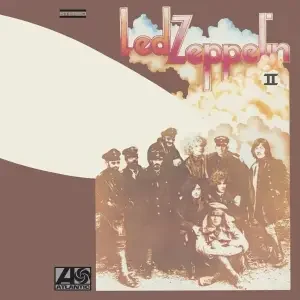Released in October 1969, Led Zeppelin II arrived like a thunderclap, solidifying the band’s place as pioneers of hard rock. Following the blues-heavy debut Led Zeppelin, this sophomore effort marked a shift toward a more aggressive and polished sound. While the first album leaned into reinterpretations of blues standards, Led Zeppelin II showcased the band’s confidence in crafting original material. It was rawer, louder, and more ambitious.
Set against the backdrop of a rapidly evolving rock scene, the album helped redefine what heavy music could sound like. Bands like Cream and Jimi Hendrix had already pushed the boundaries, but Led Zeppelin took it further by blending blues, psychedelia, and proto-metal energy into a new sonic force. This record wasn’t just a continuation. It was a declaration.
The band aimed to capture the intensity of their live performances while exploring new studio techniques. Jimmy Page, who also produced the album, pushed for layered guitar overdubs and dynamic arrangements. Robert Plant, growing more assured as a lyricist, brought a mix of mysticism and sexuality to the forefront. John Paul Jones and John Bonham locked in a rhythm section that thundered beneath the chaos, bringing structure to the wild energy.
Sonic Exploration

Led Zeppelin II doesn’t just roar—it breathes, stomps, and seduces. The production, handled by Jimmy Page, walks a tightrope between polish and raw power. Recorded in scattered sessions across North America while the band was on tour, the album captures a sense of urgency. It doesn’t sound pristine, but that’s its charm. The grit and saturation in the guitar tones, the room-like reverb on Bonham’s drums, and the occasional bleed between tracks all serve to amplify the intensity. The sound is immediate and physical, as if the band is playing in the same room with the listener.
Musical Arrangements
The arrangements throughout the album are deliberate and daring. On “Whole Lotta Love,” the breakdown middle section is a chaotic swirl of theremin, reverb-drenched vocals, and panicked guitar licks. It’s a masterclass in studio experimentation, especially for 1969. “What Is and What Should Never Be” switches dynamics with finesse, moving from dreamy verses to explosive choruses, using stereo panning in a way that was ahead of its time. Then there’s “Ramble On,” where acoustic guitars and electric riffs blend seamlessly, creating a textured backdrop for Plant’s lyrical fantasy.
Vocally, Robert Plant moves between a bluesman’s wail and a rock god’s cry. His phrasing, backed by layered harmonies or left stark against Bonham’s backbeat, adds another instrument to the mix. Jones’s bass work doesn’t just hold the low end—it dances through the tracks with melodic intent. And Bonham’s drumming, massive and intricate, shapes the dynamics from the ground up.
Genre Elements
Genre-wise, the album is a melting pot. The blues remains a foundation, but the band stretches it toward heavy metal, hard rock, and even touches of folk. “The Lemon Song” pulls from blues tradition but reimagines it with a feral energy. “Heartbreaker” and “Living Loving Maid” are proto-metal blueprints, sharp-edged and riff-driven. Yet there’s still room for nuance. “Thank You” offers a tender, organ-laced ballad that hints at the band’s softer, more reflective side.
Lyrical Analysis

The lyrics on Led Zeppelin II mirror the album’s sonic duality—rooted in tradition but unafraid to push boundaries. Robert Plant’s writing leans into blues tropes, mythology, and personal reflection, weaving them into a patchwork of themes that feel both timeless and raw. At a glance, many of the songs seem focused on love, lust, and loss, but beneath the surface there’s more at play.
Sexuality is a dominant theme, particularly on “Whole Lotta Love” and “The Lemon Song.” These tracks draw directly from blues lyricism, but Plant delivers them with a provocative edge that walks the line between homage and reinvention. His delivery adds another layer of meaning. It’s not just what he says, but how he says it—with a blend of swagger, desire, and danger.
Fantasy and escapism also emerge, especially in “Ramble On.” Drawing on J.R.R. Tolkien’s mythology, the song merges romantic longing with epic adventure. It’s a unique blend of literary influence and emotional yearning, showcasing Plant’s growing interest in storytelling. The lyrical contrast between “Ramble On” and a more grounded love song like “Thank You” is striking. In “Thank You,” Plant turns inward, offering sincere devotion in a tone that’s surprisingly tender compared to the album’s otherwise brash delivery.
Lyrical Depth
While the lyrics are not overly complex in structure, their impact comes from the emotional weight they carry and the atmosphere they help build. Many lines are open-ended enough to allow personal interpretation, which keeps the songs engaging after multiple listens. “What Is and What Should Never Be” plays with ambiguity, hinting at forbidden love or longing without ever spelling it out fully. This kind of subtlety gives the lyrics staying power.
Emotionally, the album spans a wide spectrum. It captures lust, heartbreak, wonder, and serenity within its short runtime. Plant’s voice amplifies the emotional arc. Whether he’s moaning through the sultry verses of “The Lemon Song” or baring his soul on “Thank You,” the emotional core remains sincere. The lyrics don’t need to be overly poetic to resonate—they thrive on energy, attitude, and an almost primal sense of truth.
Cohesion and Flow

Led Zeppelin II feels less like a collection of individual tracks and more like a unified experience. The sequencing of the album carries a deliberate energy, balancing power with moments of introspection. It opens with a jolt—“Whole Lotta Love” kicks down the door with its iconic riff and sets the tone for what’s to come. From there, the album moves through moods and textures without ever losing its sense of direction.
Each track flows naturally into the next, maintaining momentum while offering enough variation to keep the listener engaged. The first side hits hard with a trio of high-octane tracks before easing into the layered melodies of “Thank You.” This shift doesn’t feel abrupt; instead, it gives the listener a moment to breathe. The second side mirrors this pattern. “Heartbreaker” and “Living Loving Maid” fire off back-to-back like a single continuous surge, followed by the soulful detour of “Ramble On.” The album then closes with the slow, swaggering groove of “Bring It On Home,” bookending the record with another nod to their blues roots.
Thematic Consistency
Thematically, there is a strong throughline. Whether it’s lust, love, or longing, every track explores desire in some form. This emotional current gives the album cohesion, even as it stretches across different musical styles. The blues-rock foundation grounds the record, allowing the band to branch into psychedelic textures and softer ballads without breaking the mood.
Stylistically, Led Zeppelin II maintains a consistent palette. The guitar tones, vocal delivery, and rhythmic approach all feel part of the same world. There are no songs that feel out of place or tacked on. Even the production quirks—like stereo panning experiments or sudden tempo changes—are part of the album’s identity. They make the flow feel organic rather than overly calculated.
There may not be a strict narrative arc in the traditional sense, but the emotional trajectory is clear. The album begins with confidence and heat, dips into tenderness and fantasy, then regains its strut before winding down. It’s not storytelling in a linear way, but it does feel like a journey. And by the time the last harmonica fades out, there’s a sense of resolution.
Standout Tracks and Moments
While Led Zeppelin II is a cohesive listen from start to finish, several tracks rise to the surface as defining moments of the album—and of the band’s early legacy.
Whole Lotta Love
“Whole Lotta Love” is the obvious centerpiece. It’s not just the opening track; it’s a manifesto. That slashing guitar riff, thick with distortion and swagger, is one of the most iconic in rock history. But what truly sets it apart is the psychedelic breakdown in the middle. Page’s use of the theremin, layered with reversed echoes and panned guitar textures, created a surreal sonic trip that was unprecedented at the time. When the band slams back into the main riff, it’s a gut-punch of precision and power. This moment alone defines the band’s willingness to experiment without losing their grip on groove.
Ramble On
“Ramble On” is another standout, not just for its lyrical nods to Tolkien, but for its seamless genre-blending. It opens with a gentle acoustic riff and a relaxed vocal, only to build into electric bursts that carry emotional weight. The dynamic contrast gives it a cinematic quality, and Plant’s vocal phrasing here is particularly evocative—yearning, melodic, and textured.
Heartbreaker
Then there’s “Heartbreaker,” which delivers one of Jimmy Page’s most memorable solos. The sudden, unaccompanied guitar break midway through the song was a bold production move. It gave listeners a moment of pure, unfiltered guitar genius—raw, spontaneous, and full of bite. That solo, recorded live in a single take, became a touchstone for aspiring rock guitarists.
Thank You
“Thank You” offers a tender counterpoint to the album’s more aggressive tracks. Its organ-driven arrangement and heartfelt lyrics reveal a more introspective side of the band. Plant’s sincerity, paired with Jones’s delicate accompaniment, showcases their range and emotional depth. It’s a reminder that Zeppelin could do beauty just as well as bombast.
Memorable Moments
One of the most underrated moments comes at the end of “Bring It On Home.” The song begins as a faithful blues homage, with Plant channeling Sonny Boy Williamson over a harmonica-driven intro. But midway through, the band explodes into a hard rock stomp. The transition is jarring in the best way—like watching a storm roll in out of nowhere. It’s a final reminder of the band’s ability to honor tradition while bending it to their will.
Artistic Contribution and Innovation

Led Zeppelin II didn’t just participate in the evolution of rock—it accelerated it. At a time when the boundaries of blues rock were already being tested, this album shattered expectations. It took familiar elements—power chords, blues scales, heavy rhythms—and reassembled them into something more aggressive, more theatrical, and ultimately more influential.
Innovation
In terms of genre, the album is widely seen as a foundational text for what would become heavy metal. While it doesn’t fully embrace the darker, more dystopian themes that metal would later adopt, its sonic weight and attitude set the stage. Tracks like “Heartbreaker” and “Whole Lotta Love” established the blueprint: thick, overdriven guitar riffs, explosive drum patterns, and a sense of danger lurking beneath the surface. Few bands in 1969 were combining technical skill with raw emotion at this scale.
Led Zeppelin also redefined the role of production in rock music. Jimmy Page’s approach behind the console was innovative for the era. He treated the studio as another instrument, layering guitars to build a massive wall of sound while playing with stereo effects and reverb to create a three-dimensional feel. The experimental midsection of “Whole Lotta Love,” in particular, marked a bold move away from traditional song structures. Instead of following a verse-chorus template, it wandered into abstract territory before snapping back into a tight groove. This kind of risk-taking was rare on mainstream rock albums at the time.
Lyrically, while some songs leaned heavily into blues traditions, others like “Ramble On” brought fantasy and literature into the fold. This blend of romantic mysticism and hard-hitting rock wasn’t common in the late sixties. It gave the genre a new intellectual edge and widened the emotional spectrum that rock lyrics could explore.
Another key innovation was the band’s internal dynamic. Rather than building songs around a single star, each member had a distinct and essential voice. John Bonham’s drumming wasn’t just rhythm—it was melody, punctuation, and drive. John Paul Jones added harmonic depth and elegance. Robert Plant’s vocals pushed boundaries with their emotional range and theatrical delivery. And Jimmy Page’s guitar work wasn’t just virtuosic—it was visionary.
Closing Thoughts

Led Zeppelin II stands as a monumental achievement in the landscape of rock music. It captures a band not just finding its voice, but unleashing it with full force. Every element—from the thunderous drums to the searing guitar solos, the wild-eyed vocals to the adventurous production—works in service of a larger vision. It’s an album driven by instinct, forged in the chaos of touring, and refined with a daring studio approach that helped redefine the possibilities of rock.
Its strengths are many: the relentless energy, the tight musicianship, the sonic experimentation, and the emotional reach of its lyrics. Even the moments that lean heavily on blues tradition feel recharged, made new through the sheer force of personality and performance. The flow is natural, the themes are cohesive, and the standout moments come fast and often.
If there is a weakness to be found, it lies only in the context of how far Zeppelin would continue to push themselves in later albums. Some might argue that Led Zeppelin II is rawer and less expansive than what came later with IV or Physical Graffiti. But that’s part of its strength. It captures the band at a moment of kinetic energy, when ambition and urgency were colliding in thrilling ways.
This album not only cemented Led Zeppelin’s place among rock’s elite but also helped lay the groundwork for the next decade of heavy music. It’s a touchstone for countless bands and still feels fresh over five decades later.
Official Rating: 10/10
This is a rare case where a perfect score feels not just deserved but necessary. Led Zeppelin II is a benchmark. It’s a vital document of a band breaking new ground, a classic that still challenges and excites. For fans of rock, blues, or the outer edges of studio creativity, it remains essential listening. Its impact is lasting, its songs legendary, and its legacy unmatched.
